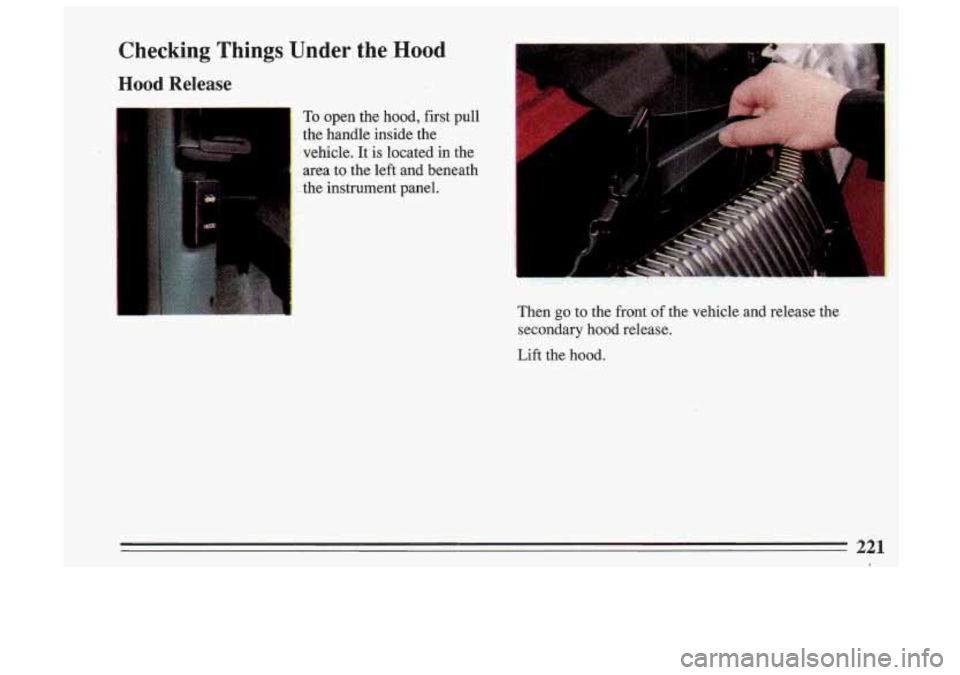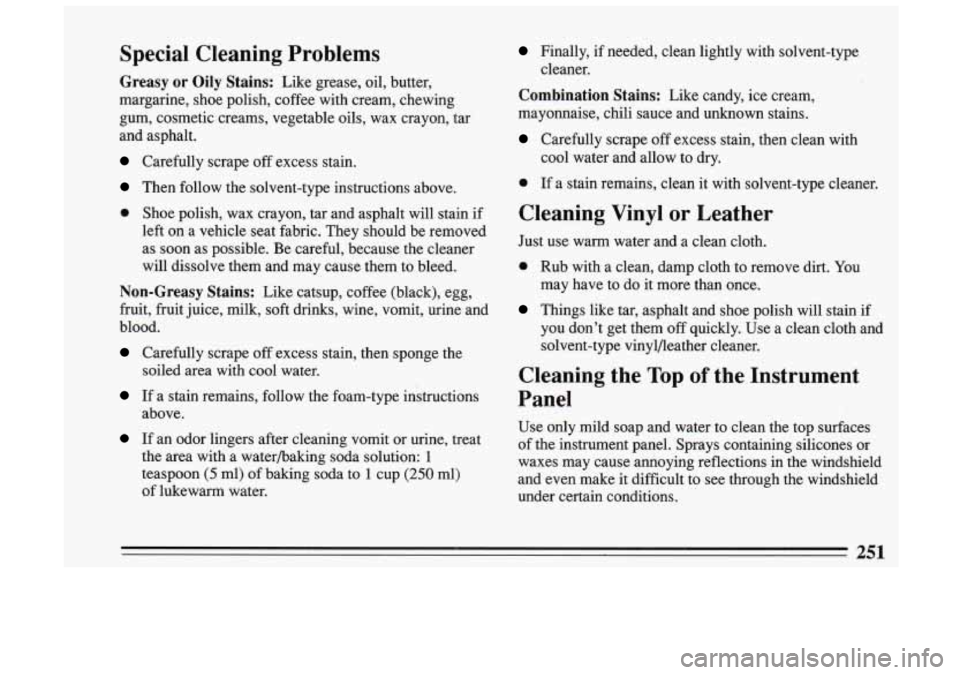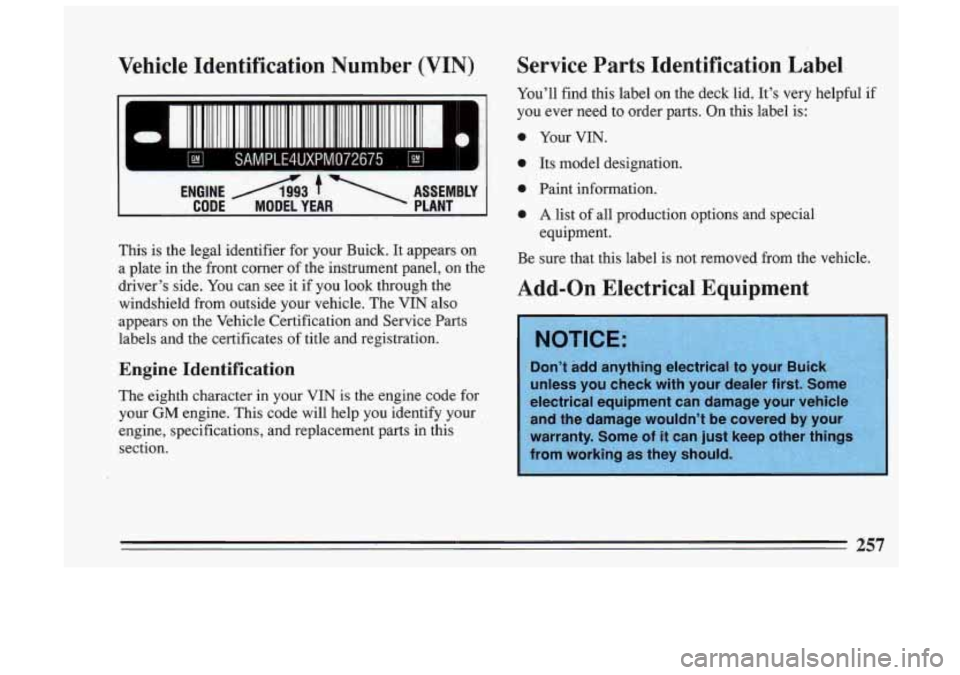1993 BUICK SKYLARK instrument panel
[x] Cancel search: instrument panelPage 122 of 306

BIL (Bi-level) Windshield Defrost
This
setting allows the outside air to flow through your
Buick in two ways. Cooler air is directed to the upper
portion of your body through the vent outlets. Slightly
warmer air
is directed through the heater ducts and
defroster outlets.
Vent
Using vent will allow outside air to flow through the
instrument panel outlets. Set the temperature knob as
desired.
Heater
On days when it’s cold outside, this setting sends heated
air through the heater ducts and
the windshield defroster
outlets. If you have the engine block heater, you can use
it in cold weather (+2OoF/-8 OC or lower) to heat your
vehicle’s passenger area quicker. The engine block
heater warms the engine coolant which
will ultimately
warm the passenger area more efficiently.
( See “Engine
Block Heater” in the Index.)
Blend
This setting divides the air flow equally between the
heater and the defroster outlets. This setting operates the defroster. Most
of the air comes
out near the windshield. Use defrost when you get fog or
ice on the windshield.
Rear Window Defogger (Option)
The lines you see on the
rear window warm
the
glass. Press the button to
start warming your
.window. Pressing the
button again will shut it off.
If you
turn the rear defogger on while driving at or
above
45 mph (72 km/h), it will stay on as long as that
speed is maintained.
You must press the button to shut
it
off.
121
Page 151 of 306

I A CAUTION.:
“Riding” your brakes can cause them to overhe;
to the point that they won’t work well. You mighl
not be able to stop your vehicle
in time to avoid
an accident. If you “ride” your brakes, they will
get
so hot they will require a lot of pedal fol- -
slow you. down. Avoid “riding” the brakes.
If you keep pace with the traffic and IW realistic
following distances, you will eliminate a lot
of
unnecessary braking. That means better braking and
longer brake life.
If your I- -dine ever stops while you’re driving, brake
normally but don’t pump your brakes.
If you do, the
pedal may get harder to push down.
If your engine
stops, you will still have some power brake assist.
But you will use it when you brake. Once the power
assist
is used up, it may take longer to stop and the
brake pedal will be harder to push.
Anti-Lock Brakes (ABS)
Your Buick has an advanced electronic braking system
that will help prevent skidding.
This light on the instrument panel will go on when you
start your vehicle.
TI-
LOCK
150
Page 184 of 306

Passing
You’ll need more passing distance up ahead when
you’re towing a trailer. And, because you’re a good deal \
longer, you’ll need to go much farther beyond the
passed vehicle before you can return to your lane.
d
Backing Up
Hold the bottom of the steering wheel with one hand.
Then, to move the trailer to the left, just move that hand
to the left. To move the trailer to the right, move your
hand to the right. Always. back up slowly and, if
possible, have someone guide you.
Making Turns
When you’re turning with a trailer, make wider turns
than normal.
Do this so your trailer won’t strike soft
shoulders, curbs, road signs, trees, or other objects.
Avoid jerky or sudden maneuvers. Signal well in
advance.
nrn Signals When Towing a Trailer
When you tow a trailer, your vehicle has to have a
different turn signal flasher and extra wiring. The green
arrows on your instrument panel will flash whenever you signal a turn or lane change. Properly hooked up, the trailer lights will also flash, telling other drivers
you’re about to turn, change lanes or stop.
When towing a trailer, the green arrows on your
instrument panel will flash for turns even if the bulbs on
the trailer are burned out. Thus, you may think drivers
behind you are seeing your signal when they are not. It’s
important to check occasionally to be sure the trailer
bulbs are still working.
Driving On Grades
Reduce speed and shift to a lower gear before you start
down a long
or steep downgrade. If you don’t shift
down, you might have to use your’brakes
so much that
they would get hot and no longer work well.
On a long uphill grade, use the highest gear. possible. If
you cannot maintain posted speeds, driving at a lower
speed may help avoid overheating your engine and
transaxle.
Parking on Hills
You really should not park your vehicle, with a trailer
attached, on a hill. If something goes wrong, your rig
could
start to move. People can be injured, and both
your vehicle and the trailer can be damaged.
183
Page 222 of 306

Checking Things Under the .Hood
Hood Release
I
To open the hood, first pull
the handle inside the
vehicle. It
is located in the
area to the left and beneath
the instrument panel.
Then
go to the front of the vehicle and release the
secondary hood release.
Lift the hood.
221
Page 252 of 306

Special Cleaning Problems
Greasy or Oily Stains: Like grease, oil, butter,
margarine, shoe polish, coffee with cream, chewing gum, cosmetic creams, vegetable oils, wax crayon, tar
and asphalt.
Carefully scrape off excess stain.
Then follow the solvent-type instructions above.
0 Shoe polish, wax crayon, tar and asphalt will stain if
left on a vehicle seat fabric. They should be removed
as soon as possible. Be careful, because the cleaner
will dissolve them and may cause them to bleed.
Non-Greasy Stains: Like catsup, coffee (black), egg,
fruit, fruit juice, milk, soft drinks, wine, vomit, urine and
blood.
Carefully scrape off excess stain, then sponge the
soiled area with cool water.
If a stain remains, follow the foam-type instructions
above.
If an odor lingers after cleaning vomit or urine, treat
the area with a waterbaking soda solution:
1
teaspoon (5 ml) of baking soda to 1 cup (250 ml)
of lukewarm water.
Finally, if needed, clean lightly with solvent-type
cleaner.
Combination Stains: Like candy, ice cream,
mayonnaise, chili sauce and unknown stains.
Carefully scrape off excess stain, then clean with
0 If a stain remains, clean it with solvent-type cleaner.
cool water and allow to dry.
Cleaning Vinyl or Leather
Just use warm water and a clean cloth.
0 Rub with a clean, damp cloth to remove dirt. You
Things like tar, asphalt and shoe polish will stain if
may have to
do it more than once.
you don’t get them
off quickly. Use a clean cloth and
solvent-type vinylbeather cleaner.
Cleaning the Top of the Instrument
Panel
Use only mild soap and water to clean the top surfaces
of the instrument panel. Sprays containing silicones or
waxes may cause annoying reflections in the windshield
and even make it difficult to see through the windshield
under certain conditions.
251
Page 258 of 306

Vehicle Identification Number (VIN)
1111 11111 11. II I I 111 I II 11111 111 I11111 111 IIIIIIIIII II 1111 Ill II
ENGIME A3 t AQEMBLY
CODE MODEL YEAR. PLANT
This is the legal identifier for your Buick. It appears on
a plate in the front corner of the instrument panel, on the
driver’s side. You can see it if you look through the
windshield from outside your vehicle. The
VIN also
appears on the Vehicle Certification and Service Parts
labels and the certificates of title and registration.
Engine Identification
The eighth character in your VIN is the engine code for
your
GM engine. This code will help you identify your
engine, specifications, and replacement parts in this
section.
Service Parts Identification Label
You’ll find this label on the deck lid. It’s very helpful if
you ever .need to order parts. On this label is:
0 Your VIN.
0 Its model designation.
0 Paint information.
0 A list of all production options and special
Be sure that this label is not removed from the vehicle. equipment.
Add-on
Electrical Equipment
257
Page 260 of 306

~~ Fuse Usage
Amp Description
1.
2.
3.
4.
5.
6.
7.
8.
9.
10.
11.
12.
13.
14.
15.
16.
17.
18.
19.
20.
21. 10
20
20
15
5
5
10
15
15
25
10
20
20
20
30
25 15
20
30
20
20 PRNDL
F/P INJ
STOP HAZ
CTSY
RKE
INST LPS
GAUGES
HORN
ALARM HTR-A/C
RDO IGN
TURN DR LK
TAIL LPS
WDO
WIPER
ERLS
FTP
ACC
IGN ECM HDLP Backup Lamps, Electronic PRNDL Display
Fuel Pump, Fuel Injectors
Stop Lamps, Hazard Flashers
Trunk Lamp,-Door Lock Switches, Power Mirrors
(Automatic Transmission Only) Remote Keyless Entry
Instrument Panel Lighting
Gauges, Rear Defog Relay, Antilock Brake Telltale, Brake Transmi\
ssion Shift Interlock
Horn
Multi-Function Alarm Module
Heater, Air Conditioning, Antilock Brakes, Daytime Running Lamps \
(Canada), Computer Controlled Ride
Radio Power, Cruise Control
Turn Signals
Power Door Lock Relay
.Tail Lamps, Marker Lamps, License Lamps (Circuit Breaker) Power Windows
Windshield Wipers Engine controls
Flash-to-Pass
(U.S. Only)
(Circuit Breaker) Rear Window Defogger, Power Door Locks, Powe\
r Seats, Power Antenna
Ecm, Ignition System (Circuit Breaker) Headlamps
259
Page 296 of 306

Children and Safety Belts .......................... 44
Cigarette Lighter
................................ 106
Circuit Breakers and Fuses
........................ 258
City Driving
.................................... 165
Cleaner. Air
.................................... 228
Cleaning Aluminum Wheels
............................ 253
Fabric
...................................... 249
Glass
....................................... 252
InsideofyourCar
............................. 249
Instrument Panel Top
.......................... 251
Power Antenna
............................... 134
Safety Belts
.................................. 252
Underbody Of Your Car
........................ 255
Vinyl and Leather ............................. 251
Weather Strips
................................ 254
White Sidewall Tires
............................ 254
Windshield and Wiper Blades
.................... 252
Coat Hanger
.................................... 107
Comfort Control System
.......................... 119
Clock. Setting the
......................... 125.127. 129
Closed-In Places. Don’t Idle in
...................... 85
CO in Your Exhaust ............................... 84
Color of Road Signs
.............................. 138
Comfort Controls and Audio Systems
................ 119
Compact Disc Care
.............................. 133
Compact Spare Tire
.............................. 2 12
Contents. Table of
................................. 9
Control of a Vehicle ............................... 148
Outside
of your Car
........................... 252 Control. Loss
of
................................. 158
Convenience Net
................................ 104
Convex Outside Mirror
............................ 104
Coolant. Engine
................................. 231
Coolant. Engine Warning Light
..................... 112
Coolant. Safety Warnings About
.................... 197
Courtesy Lights
................................. 102
Covers. How To Remove Wheel
.................... 206
Cruise Control
................................... 93
Cruise Control. Changing Speed With
................. 96
Cruise Control on Hills
............................ 97
Cruise Control. Turning
Off ......................... 98
Curves. Driving On
............................... 154
Customer Assistance for the Hearing/Speech Impaired
... 286
Customer Assistance Information
................... 285
Customer Satisfaction Procedure
.................... 285
D (Drive) Third Gear ............................. 78
Damage to Finish
................................ 254
Damage to Sheet Metal
............................ 254
Damage Warnings
................................ 11
Daytime Running Lights
.......................... 100
Defensive Driving
............................... 144
Defogger. Rear Window
.......................... 121
Dimensions
.................................... 261
Disc Brake Wear Indicators
........................ 152
Disposal of Used Oil
............................. 227
DoorLocks
...................................... 63
295